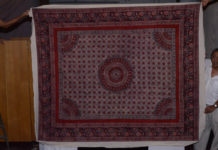Calico is one of Iran traditional prints on the cloth in which the design is transferred through putting the format or stencil dipped in print ink or the paint on the cloth and tapping on its back side. In this, the format is called “block”. The type of cloth used in this print should be cotton so it could have the greatest absorption rate. The carved material is wood. After finishing and drying the cloth, it is rinsed in cold water and flowing natural waters so we could be sure that the paints are stable and not varied. Then it is boiled in pomegranate peel juice and madder ink. Afterwards, coloring and rinsing and boiling stages are repeated one time. The patterns in this print are floral, although animal and human patterns and sometimes geometrical patterns are also seen. One of the most famous calico patterns is paisley. Calligraphy can also be printed in this way.
 In the past, besides printing, the cloth is painted by brush, but this method was gradually abolished and block printing gained popularity because it was much easier. One of the main reasons for calico printing progress was frequent export of Iran brocade clothes to Europe in seventeenth of Safavid era which replaced calico for brocade.
In the past, besides printing, the cloth is painted by brush, but this method was gradually abolished and block printing gained popularity because it was much easier. One of the main reasons for calico printing progress was frequent export of Iran brocade clothes to Europe in seventeenth of Safavid era which replaced calico for brocade.
Since past till now printed calico is frequently used in applications such as table, tablecloth, prayer, clothing, bags and shoes, lampshade, and cushion.
Historical artists are not known, but active contemporary artists include Abbas Giahi, Morteza Jafari, and Ali Zabolian. The training method of this art in Iran is in a traditional way using brush and block, taught from professor to student. Isfahan City is superior in this regard.





